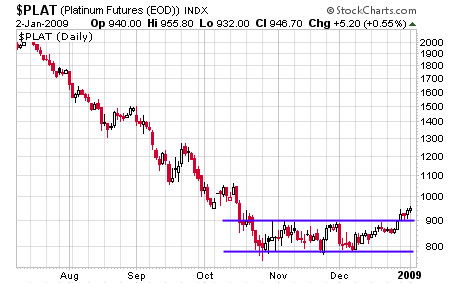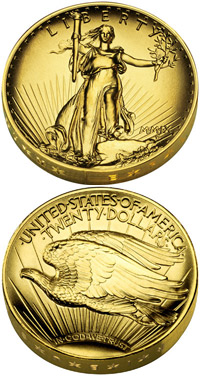 With the first quarter at an end, let’s take a look at the performance of gold, silver, and platinum so far this year.
With the first quarter at an end, let’s take a look at the performance of gold, silver, and platinum so far this year.
When putting the numbers together, I knew what to expect, but its still surprising to see where the final numbers landed. Gold, silver, and platinum’s performance relative to one another has basically been turned upside down from the 2008 annual performance.
| 2009 First Quarter Gold, Silver, and Platinum Performance | ||||
| 30-Dec-08 | 31-Mar-09 | Change | Percent | |
| Gold | 869.75 | 916.50 | 46.75 | 5.38% |
| Silver | 10.79 | 13.11 | 2.32 | 21.50% |
| Platinum | 898.00 | 1,124.00 | 226.00 | 25.17% |
For 2008, gold had performed the best with a gain of 4.32%, followed by silver with a loss of 26.90%, with platinum in last place with a loss of 41.31%.
As you can see the performance for the first quarter of 2009 has been the opposite with platinum performing best with a gain of 25.17%, followed by silver with a gain of 21.50%, with gold in last place with a gain of 5.38%.
Platinum and silver were in some respects recovering from the beating they took last year. Over the past several years gold has emerged as more of a steady performer, as compared to the more volatile performance of the other metals, commodities, equities, real estate, etc. It’s ironic that whenever a mainstream publication discusses the possibility of investing in gold, they never fail to caution about gold’s “volatile” prices.
At any rate, precious metals outperformed stocks for the quarter, mostly by a wide margin. The Dow, S&P 500, and Nasdaq lost 14.29%, 12.81%, and 3.07% respectively.

 In the past week, gold quietly marked two important milestones.
In the past week, gold quietly marked two important milestones. For much of the year, the United States Mint has been touting the upcoming recreation of what they have called the “nation’s most beautiful coin.” Augustus Saint Gaudens’ design for the
For much of the year, the United States Mint has been touting the upcoming recreation of what they have called the “nation’s most beautiful coin.” Augustus Saint Gaudens’ design for the  Today the United States Mint announced some sweeping cuts to the number of products that they will offer to coin collectors. The deepest cuts take place in the US Mint’s offerings of collectible versions of gold and platinum bullion coins.
Today the United States Mint announced some sweeping cuts to the number of products that they will offer to coin collectors. The deepest cuts take place in the US Mint’s offerings of collectible versions of gold and platinum bullion coins.